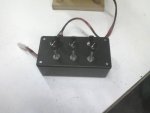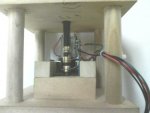Hey guys, I just started making one of these.
I'm about 60-70% done, my design uses no sliprings. I was pondering about how to get around their use, when I got an idea I had to test. Turns out on the motors I use, the metal motor body/metal shaft are isolated from the terminals. So I simply soldered a wire to the shaft and attached the wire to the turning axis to power the motors on that axis, and supplied power to the motor body (Body is apparently conductive to the shaft). So far this method has been a complete success, and I suggest you all test your DC motors to see if the shaft is isolated from the power terminals.
I also use two motors to rotate each axis. I'm undecided if I'm going to power both motors, as I'm not sure if the RPMs will match correctly, but even if I do end up powering only 1 motor, the other will serve as the perfect counterbalance for it.
The wooden axis with the arch and the axis that was made by soldered wire are replaced by a model I drew up last night around midnight and 3d printed (I'm a senior in highschool, friends with the tech teacher, so I have full access to a dimension 3d printer) out of black ABS plastic.
I've really got to thank the OP, this came just in time. I've been stressed and looking for something to make my girlfriend for christmas, and as soon as I saw this I knew it had to be done. You really saved my ass.
Pictures coming soon, I'm on dialup internet so it'll be a while. So far I have the "arch" axis and the "soldered metal wire" axis completely attached, balanced and motor/wired up. Working on the axis that the LEDs mount on, and the body that will rotate the "arch" axis.
Thanks again for a great project, really came with perfect timing. If this one is successful, I'm probably going to make a few more for friends/technology teacher.
I'm about 60-70% done, my design uses no sliprings. I was pondering about how to get around their use, when I got an idea I had to test. Turns out on the motors I use, the metal motor body/metal shaft are isolated from the terminals. So I simply soldered a wire to the shaft and attached the wire to the turning axis to power the motors on that axis, and supplied power to the motor body (Body is apparently conductive to the shaft). So far this method has been a complete success, and I suggest you all test your DC motors to see if the shaft is isolated from the power terminals.
I also use two motors to rotate each axis. I'm undecided if I'm going to power both motors, as I'm not sure if the RPMs will match correctly, but even if I do end up powering only 1 motor, the other will serve as the perfect counterbalance for it.
The wooden axis with the arch and the axis that was made by soldered wire are replaced by a model I drew up last night around midnight and 3d printed (I'm a senior in highschool, friends with the tech teacher, so I have full access to a dimension 3d printer) out of black ABS plastic.
I've really got to thank the OP, this came just in time. I've been stressed and looking for something to make my girlfriend for christmas, and as soon as I saw this I knew it had to be done. You really saved my ass.
Pictures coming soon, I'm on dialup internet so it'll be a while. So far I have the "arch" axis and the "soldered metal wire" axis completely attached, balanced and motor/wired up. Working on the axis that the LEDs mount on, and the body that will rotate the "arch" axis.
Thanks again for a great project, really came with perfect timing. If this one is successful, I'm probably going to make a few more for friends/technology teacher.












